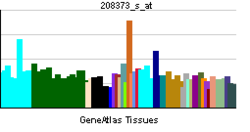P2RY6
From Wikipedia, the free encyclopedia
P2Y purinoceptor 6 is a protein that in humans is encoded by the P2RY6 gene.[4][5]
Function[edit]
The product of this gene, P2Y6, belongs to the family of G-protein coupled receptors. This family has several receptor subtypes with different pharmacological selectivity, which overlaps in some cases, for various adenosine and uridine nucleotides. This receptor is responsive to UDP, partially responsive to UTP and ADP, and not responsive to ATP. Four transcript variants encoding the same isoform have been identified for this gene.[5]
See also[edit]
References[edit]
- ^ "Drugs that physically interact with Pyrimidinergic receptor P2Y6 view/edit references on wikidata".
- ^ "Human PubMed Reference:".
- ^ "Mouse PubMed Reference:".
- ^ Communi D, Parmentier M, Boeynaems JM (May 1996). "Cloning, functional expression and tissue distribution of the human P2Y6 receptor". Biochemical and Biophysical Research Communications. 222 (2): 303–8. doi:10.1006/bbrc.1996.0739. PMID 8670200.
- ^ a b "Entrez Gene: P2RY6 pyrimidinergic receptor P2Y, G-protein coupled, 6".
Further reading[edit]
- Maier R, Glatz A, Mosbacher J, Bilbe G (Aug 1997). "Cloning of P2Y6 cDNAs and identification of a pseudogene: comparison of P2Y receptor subtype expression in bone and brain tissues". Biochemical and Biophysical Research Communications. 237 (2): 297–302. doi:10.1006/bbrc.1997.7135. PMID 9268704.
- Somers GR, Hammet F, Woollatt E, Richards RI, Southey MC, Venter DJ (Aug 1997). "Chromosomal localization of the human P2y6 purinoceptor gene and phylogenetic analysis of the P2y purinoceptor family". Genomics. 44 (1): 127–30. doi:10.1006/geno.1997.4841. PMID 9286708.
- Pidlaoan LV, Jin J, Sandhu AK, Athwal RS, Kunapuli SP (Jul 1997). "Colocalization of P2Y2 and P2Y6 receptor genes at human chromosome 11q13.3-14.1". Somatic Cell and Molecular Genetics. 23 (4): 291–6. doi:10.1007/BF02674420. PMID 9542531. Check date values in:
|year= / |date= mismatch(help) - Brinson AE, Harden TK (Apr 2001). "Differential regulation of the uridine nucleotide-activated P2Y4 and P2Y6 receptors. SER-333 and SER-334 in the carboxyl terminus are involved in agonist-dependent phosphorylation desensitization and internalization of the P2Y4 receptor". The Journal of Biological Chemistry. 276 (15): 11939–48. doi:10.1074/jbc.M009909200. PMID 11114308.
- Moore DJ, Chambers JK, Wahlin JP, Tan KB, Moore GB, Jenkins O, Emson PC, Murdock PR (Oct 2001). "Expression pattern of human P2Y receptor subtypes: a quantitative reverse transcription-polymerase chain reaction study". Biochimica et Biophysica Acta. 1521 (1-3): 107–19. doi:10.1016/S0167-4781(01)00291-3. PMID 11690642.
- Hou M, Harden TK, Kuhn CM, Baldetorp B, Lazarowski E, Pendergast W, Möller S, Edvinsson L, Erlinge D, Schmoldt A, Benthe HF, Haberland G, Klimpel GR, Day KD, Lucas DO, Kalyanaraman VS, Mahadevan S, Kumar SA, Wachter RF, Briggs GP, Pedersen CE, Nozaki M, Bose KS, Sarma RH, Granström G, Linde A (Nov 1975). "UDP acts as a growth factor for vascular smooth muscle cells by activation of P2Y6 receptors". Am J Physiol Heart Circ Physiol. 282 (2): H784–92. doi:10.1152/ajpheart.00997.2000. PMID 11788430. Check date values in:
|year= / |date= mismatch(help) - Loomis WH, Namiki S, Ostrom RS, Insel PA, Junger WG (Feb 2003). "Hypertonic stress increases T cell interleukin-2 expression through a mechanism that involves ATP release, P2 receptor, and p38 MAPK activation". The Journal of Biological Chemistry. 278 (7): 4590–6. doi:10.1074/jbc.M207868200. PMID 12464620.
- Kim SG, Soltysiak KA, Gao ZG, Chang TS, Chung E, Jacobson KA (Mar 2003). "Tumor necrosis factor alpha-induced apoptosis in astrocytes is prevented by the activation of P2Y6, but not P2Y4 nucleotide receptors". Biochemical Pharmacology. 65 (6): 923–31. doi:10.1016/S0006-2952(02)01614-3. PMC 3402349
 . PMID 12623123.
. PMID 12623123. - Schafer R, Sedehizade F, Welte T, Reiser G (Aug 2003). "ATP- and UTP-activated P2Y receptors differently regulate proliferation of human lung epithelial tumor cells". American Journal of Physiology. Lung Cellular and Molecular Physiology. 285 (2): L376–85. doi:10.1152/ajplung.00447.2002. PMID 12691958.
- Lee H, Choi BH, Suh BC, Lee SK, Kim KT (May 2003). "Attenuation of signal flow from P2Y6 receptor by protein kinase C-alpha in SK-N-BE(2)C human neuroblastoma cells". Journal of Neurochemistry. 85 (4): 1043–53. doi:10.1046/j.1471-4159.2003.01761.x. PMID 12716436.
- Wan D, Gong Y, Qin W, Zhang P, Li J, Wei L, Zhou X, Li H, Qiu X, Zhong F, He L, Yu J, Yao G, Jiang H, Qian L, Yu Y, Shu H, Chen X, Xu H, Guo M, Pan Z, Chen Y, Ge C, Yang S, Gu J (Nov 2004). "Large-scale cDNA transfection screening for genes related to cancer development and progression". Proceedings of the National Academy of Sciences of the United States of America. 101 (44): 15724–9. doi:10.1073/pnas.0404089101. PMC 524842
 . PMID 15498874.
. PMID 15498874. - Cox MA, Gomes B, Palmer K, Du K, Wiekowski M, Wilburn B, Petro M, Chou CC, Desquitado C, Schwarz M, Lunn C, Lundell D, Narula SK, Zavodny PJ, Jenh CH (May 2005). "The pyrimidinergic P2Y6 receptor mediates a novel release of proinflammatory cytokines and chemokines in monocytic cells stimulated with UDP". Biochemical and Biophysical Research Communications. 330 (2): 467–73. doi:10.1016/j.bbrc.2005.03.004. PMID 15796906.
- Khine AA, Del Sorbo L, Vaschetto R, Voglis S, Tullis E, Slutsky AS, Downey GP, Zhang H (Apr 2006). "Human neutrophil peptides induce interleukin-8 production through the P2Y6 signaling pathway". Blood. 107 (7): 2936–42. doi:10.1182/blood-2005-06-2314. PMID 16322472.
- Wihlborg AK, Balogh J, Wang L, Borna C, Dou Y, Joshi BV, Lazarowski E, Jacobson KA, Arner A, Erlinge D (Apr 2006). "Positive inotropic effects by uridine triphosphate (UTP) and uridine diphosphate (UDP) via P2Y2 and P2Y6 receptors on cardiomyocytes and release of UTP in man during myocardial infarction". Circulation Research. 98 (7): 970–6. doi:10.1161/01.RES.0000217402.73402.cd. PMC 3492942
 . PMID 16543499.
. PMID 16543499. - Dulong S, Bernard K, Ehrenfeld J (2007). "Enhancement of P2Y6-induced Cl- secretion by IL-13 and modulation of SK4 channels activity in human bronchial cells". Cellular Physiology and Biochemistry. 20 (5): 483–94. doi:10.1159/000107532. PMID 17762175.
External links[edit]
- "P2Y Receptors: P2Y6". IUPHAR Database of Receptors and Ion Channels. International Union of Basic and Clinical Pharmacology.
This article incorporates text from the United States National Library of Medicine, which is in the public domain.
| This transmembrane receptor-related article is a stub. You can help Wikipedia by expanding it. |
